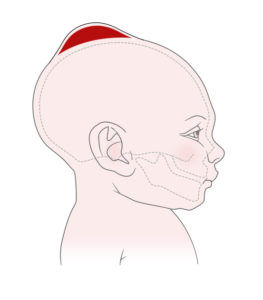What is newborn cephalohematoma?
Newborn cephalohematoma is a birth injury caused by a buildup of ruptured blood vessels in the tissue that covers an infant’s skull (periosteum).
 The hematoma will cause a collection of blood to pool around the damaged blood vessels, causing a visible red spot on the child’s scalp. The pooled blood can put pressure on the brain’s tissue, which can cause significant disabilities or even death if it is not treated in a timely manner.
The hematoma will cause a collection of blood to pool around the damaged blood vessels, causing a visible red spot on the child’s scalp. The pooled blood can put pressure on the brain’s tissue, which can cause significant disabilities or even death if it is not treated in a timely manner.
Thankfully, many cases of newborn cephalohematoma do not cause significant brain damage and will heal on their own, without medical treatment. Severe cases of newborn hematomas may require immediate treatment; otherwise, they could lead to fatal complications.
Newborn cephalohematoma vs. caput succedaneum
Caput succedaneum is a birth injury caused by pressure during childbirth, which can lead to swelling of the scalp. This differs from newborn hematoma because it does not involve ruptured blood vessels under the scalp itself.
Caput succedaneum often occurs during difficult, prolonged, or vacuum deliveries. This birth injury often clears up on its own by the third day of a baby’s life, whereas newborn cephalohematoma can affect a child for weeks or even months.
If you believe your child suffered from newborn cephalohematoma during birth, talk to one of our trusted registered nurses to learn more about the next steps in getting treatment.
Newborn cephalohematoma types
There are several types of newborn cephalohematomas that can occur during the birthing process.
The two types of newborn hematomas include:
- Acute infant hematoma: Hematoma symptoms may show immediately or shortly after birth.
- Chronic infant hematoma: Hematoma symptoms may not show until days or weeks after delivery.
Acute infant hematoma cases that are not treated promptly and correctly may lead to chronic infant hematoma. Because of this, early diagnosis and treatment are incredibly important in ensuring your child does not suffer long-term complications.
Causes of newborn hematoma
Birth trauma to an infant’s head can lead to cases of newborn cephalohematoma. Trauma that causes newborn hematoma has been linked to several different factors in the delivery process.
A difficult labor that increases pressure on the child’s head (and potentially, their brain) is often associated with newborn cephalohematoma. Placing pressure on the child’s head for a significant amount of time can increase the risk of developing a hematoma.
Common newborn cephalohematoma causes include:
- Assistive delivery: Forceps and vacuum delivery are often used to speed up difficult births. They can also cause significant pressure on the baby’s brain, which may cause hematomas.
- Infant size: Large babies (8 pounds, 13 ounces or more) can have difficulty exiting the birth canal, causing compression and pressure on the child’s head, leading to hematomas.
- Medical negligence: Doctors are trained to safely deliver babies without injury or complications. Preventable mistakes made during delivery can lead to newborn cephalohematoma and other birth injuries.
If you believe your child’s birth injury could have been prevented and was caused by medical negligence, you may be able to seek legal help.
Newborn cephalohematoma risk factors
Knowing the risk factors for newborn cephalohematoma could potentially help you prevent your child from developing this condition.
Risk factors that may cause newborn hematomas include:
- Breech fetus (feet or buttocks first delivery)
- Difficult childbirth
- Having a multiple birth (twins or triplets)
- Large fetus size of more than 8 pounds, 13 ounces (macrosomia)
- Preterm birth
- Use of forceps or vacuum extraction
Infant hematomas occur in 0.4% to 2.5% of all live births, according to a study by Thomas Jefferson University Hospital and the University at Buffalo.
Newborn cephalohematoma symptoms
There are several symptoms of newborn cephalohematoma to watch for if you believe your child suffered a birth injury.
Newborn hematoma symptoms can differ depending on the severity of the injury. It is important to remember each case is different and your child’s symptoms may vary.
Common newborn cephalohematoma symptoms include:
- Difficulty feeding
- Fatigue
- Head swelling
- High-pitched crying
- Large head
- Seizures
- Soft spots on head (bulging fontanel)
- Vomiting
Some children show signs of newborn cephalohematoma immediately after birth. Other symptoms may take a few days or weeks to show.


Newborn cephalohematoma can also cause a variety of different complications affecting a child’s overall health.
Complications of newborn cephalohematoma include:
- Anemia (low blood-cell count)
- Calcification (bone deposits harden around hematoma)
- Infection
- Jaundice (buildup of bilirubin)
- Skull fractures
If your child is showing signs of complications from a hematoma, be sure to contact a doctor and seek medical intervention.
Newborn hematoma diagnosis
It is important to contact your child’s pediatrician if your child is showing any signs of infant cephalohematoma.
There are several steps a pediatrician will take in order to make a newborn cephalohematoma diagnosis.
The steps in diagnosing an infant hematoma include:
- Blood tests: Doctors will run a hematocrit test to check your child’s red blood cell count compared to the rest of the blood in their body. This can be an indication of hematoma.
- Imaging scans: X-rays, CT (computed tomography) scans, and MRI (magnetic resonance imaging) scans can help doctors find the size and location of the hematoma.
- Physical examination: Your baby’s doctor will examine your child’s head to see if it is growing or expanding more than normal.
Getting an early diagnosis can help your child receive prompt treatment for newborn cephalohematoma, which can prevent long-term complications or even death.
Treatment for newborn cephalohematoma
Once your child is diagnosed with newborn cephalohematoma, their doctor may recommend a variety of treatment options depending on your child’s specific needs.
Mild newborn cephalohematoma cases clear up on their own with time and rest. More severe hematomas may require surgery. A doctor may recommend surgery to remove blood clots, fix bleeding veins, or drain excess blood due to trauma.
Proper treatment can prevent severe issues affecting a child’s overall development. Thankfully, many children are able to make a full recovery.
Get newborn cephalohematoma legal help
Unfortunately, many cases of newborn cephalohematoma could have been prevented with quality care during delivery.
Medical mistakes by doctors, nurses, or other health care professionals can cause birth injuries such as newborn cephalohematoma. Some of these errors are considered medical negligence.
If you believe your child’s hematoma was caused by improper medical care during childbirth, you may qualify for financial compensation to help pay for your child’s birth injury treatment.
Get a free case review today to see if you qualify for medical malpractice legal help.




